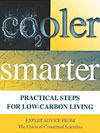One of the many reasons I love the arrival of spring is that it allows me to turn down the home furnace, open up the windows, and soak in the fresh air. As a self-professed energy geek, springtime also puts a smile on my face because it is the time of year when I crunch the numbers on dollars saved and carbon emissions avoided from our investments in home energy efficiency. This year, with the release of our new book Cooler Smarter: Practical Steps to Low-Carbon Living, I’m sharing all the number crunching I do on household energy with you.
Home Is Where the Carbon Is
 This is part of a series on Cooler Smarter: Practical Steps for Low-Carbon Living.
This is part of a series on Cooler Smarter: Practical Steps for Low-Carbon Living.
When it comes to your personal carbon emissions, how you use energy in your home is second only to how you get around, roughly seven tons’ worth of carbon dioxide per person annually for most of us or one-third of the total. More than half of these household energy emissions derive from heating and cooling. So when my wife and I bought our first home in 2009, a 75-year old colonial-style that was built solidly, but not with a mind toward efficiency, we were committed to reducing our emissions and one of our first orders of business was insulation.
Stop Heating and Cooling Your Neighborhood
There are all kinds of places that air escapes from your home (see figure below). Floors, walls, and ceilings are the largest culprits, but even electrical outlets on outer walls can cause pesky drafts. In fact, air leaks in the average American home account for as much as 15 to 25 percent of the heat our furnaces generate in winter or that our homes gain in summer. That’s equivalent to leaving a window in your home wide open all year round!

Air can escape from multiple sources in a home, including floors, ceilings, walls, doors, and fireplaces.
In our home, we started with the attic, rolling out two layers of insulation ourselves. We then took advantage of a state incentive program (you can find incentives in your state by visiting the DSIRE database) to hire a contractor that conducted an energy audit, sealed up leaks throughout the house, and blew cellulose insulation into the walls. We also insulated steam pipes in the basement and found reflective insulation to place behind our recessed wall radiators to help bring more heat into our living space.

Installing and properly using a programmable thermostat is an effective step to improve the efficiency of your home, save money, and cut carbon emissions.
Fear Not Your Programmable Thermostat
The other significant change we made, even before insulating, was to install a programmable thermostat and set it to automatically lower the heat while we sleep and are away at work. This is hands down the easiest and cheapest thing anyone can do to reduce their carbon footprint—as much as fifteen percent from your heating and cooling emissions. But, interestingly, one of this things we discovered while researching Cooler Smarter is that many Americans own these devices but have never programmed them to achieve the energy savings they can deliver. That’s unfortunate, because programming a thermostat along with all the insulation improvements have made a huge difference in my home.
Money in Our Pocket and Carbon Off Our Back
We are one of the 7 percent of U.S. households—mostly in New England—that heat our homes using furnaces fueled by oil. Last year, we saved more than 100 gallons of heating oil and $400 compared with our first winter in the house, which was a particularly snowy one. This year, thanks also in part to an unusually warm season, we are on pace to save more than 150 gallons of heating oil. At current prices, that amounts to a savings of about $600 for the season—a good chunk of money to put toward paying back our initial $3,000 investment. It’s also nearly 2 tons of carbon dioxide emissions that won’t be going into the atmosphere, which is well on the way of achieving my goal of a twenty percent reduction in annual carbon emissions. That is as good a reason as any to smile on a nice spring day.
To get started in reducing your carbon emissions, visit www.coolersmarter.org.
